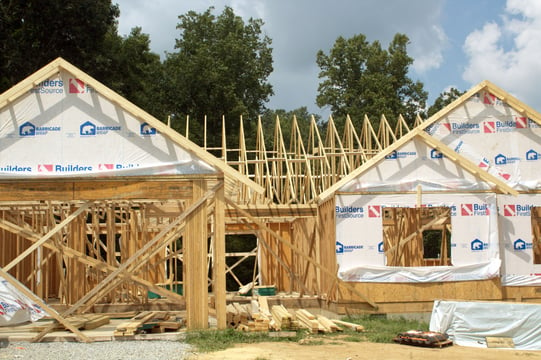
When buying a house, most people are very familiar with the process of applying for a mortgage, purchasing, and moving into a home that is already built. However, the situation is slightly different when building a new home from the ground up. Financing the building of a new custom home requires a specific type of home-building loan, which differs from standard mortgages.
So what are home construction loans, how do they work, what’s their interest rate, and what are the down payment requirements? Let’s dig into it.
Standard Mortgages vs. Home Construction Loans
A traditional home loan is known as a "mortgage.” Generally, a mortgage is a loan with a 15-year or 30-year term at a fixed or adjusted rate, where the borrower makes principal and interest payments for the life of the loan (read more on how to calculate your potential mortgage payment). These types of loans can be obtained through conventional lenders or special lending programs such as the Federal Housing Administration (FHA) and the Veterans Administration (VA) if qualified.
Do the math >> How to Calculate Your Potential Mortgage Payment
However, bear in mind that mortgages only apply to existing homes. This distinction is important, as it is the heart of the difference between conventional mortgages and construction loans.
Specifically, construction loans become relevant when constructing a new home, covering everything from the land purchase to completing the final structure. Since these loans normally reflect the time needed to build your home, they typically have a shorter duration, ranging from six months to a year.
How Do Home Construction Loans Work?
Once the loan has been approved and the construction process begins, the lender will monitor the progress of the project and pay the builder at designated intervals. These payments are referred to as draws, and there may be several of them throughout the project.
For example, if you have a $350,000 construction loan, you won’t have to actually start paying anything on it until your builder requests a draw (perhaps something like $30,000 to start), and then you’ll only pay the interest on that $30,000.
Construction Loan Interest Rate
Construction loans typically carry higher interest rates than conventional mortgages. In most cases, the loan’s interest rate isn’t fixed, implying that your payments may vary based on changes in prime interest rates. Some lenders, though, will offer a fixed rate in exchange for a larger down payment or higher closing costs and fees.
But remember!
For most construction loans, whether they’re variable or fixed-rate, interest is charged only on the money that has been actually paid out and not the full amount. This means that your payments start lower and then scale up as more money is drawn to pay the builder. Also, as already mentioned, construction loans aren't meant to be long-term, which could come as a relief since you don’t have to pay higher rates over an extended period.
Construction Loan Down Payment
Down payment requirements for construction loans depend on several factors, including the lender, land cost, and build budget. If you already own the land, you can use it as equity for your construction loan.
Generally speaking, construction loans demand a higher down payment than mortgages - usually between 20-30% of total home value, compared to a 3.5-20% range for standard mortgages.
The higher upfront investment (and the higher interest rate) aim to mitigate the added risk lenders take on with this type of financing. Unlike a mortgage for an existing home, the unfinished property itself provides no collateral for the lender to recoup costs if the borrower defaults. Consequently, construction loans are perceived as riskier for the lender, necessitating additional safeguards.
Can You Convert A Construction Loan into A Mortgage?
To fully answer this question, we need to distinguish between two types of home construction loans:
- Construction-Only Loan: These interim loans only cover building costs. At maturity (typically under one year), borrowers must either pay off the loan entirely or apply for separate permanent mortgage financing. This option avoids long-term high interest rates but requires paying closing costs twice.
- Construction-to-Permanent Loan: This all-in-one option starts as a short-term construction loan, and once the building project is complete, it turns into a traditional fixed-rate or adjustable-rate mortgage, usually with a 15-30-year term. This type of loan benefits those who can’t settle the remaining loan amount. And just so you know, you don't need to get your mortgage through the same lender you use for your construction loan.
So, in short - yes, construction loans can convert into mortgages, but only if you select a construction-to-permanent financing option.
Construction Loans Offer Viable Home Building Financing
For those debating over building or buying a house and concerned about financing, construction loan financing makes a new build possible. Despite the initial high interest rates and down payment, this loan caters to the unique demands of many who envision their custom dream home.
Build with Vista Developers for Peace of Mind
At Vista Developers, we work with our clients on selecting a lot in one of our beautiful mountainside communities, and from there, we help make their dream homes come true.
If you are looking to relocate or build in the Hendersonville and Lake Lure, North Carolina area, contact us online or call (866) 519-2400.


